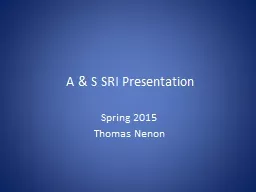PPT-A & S SRI Presentation
Author : lindy-dunigan | Published Date : 2016-03-18
Spring 2015 Thomas Nenon AampS SRI Basic Facts The implementation of the SRI at the University of Memphis will not involve any automatic shifts in college budgets
Presentation Embed Code
Download Presentation
Download Presentation The PPT/PDF document "A & S SRI Presentation" is the property of its rightful owner. Permission is granted to download and print the materials on this website for personal, non-commercial use only, and to display it on your personal computer provided you do not modify the materials and that you retain all copyright notices contained in the materials. By downloading content from our website, you accept the terms of this agreement.
A & S SRI Presentation: Transcript
Download Rules Of Document
"A & S SRI Presentation"The content belongs to its owner. You may download and print it for personal use, without modification, and keep all copyright notices. By downloading, you agree to these terms.
Related Documents














